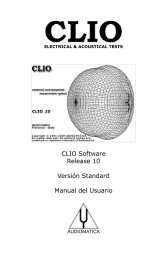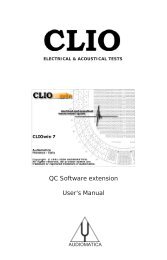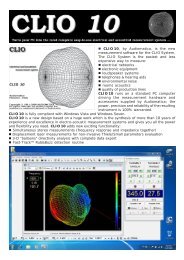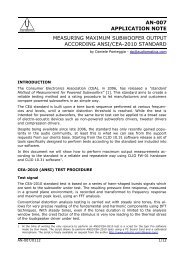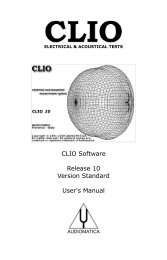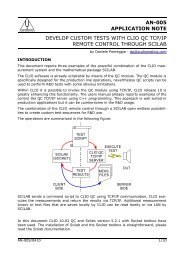CLIOwin 7 PCI User's Manual - Audiomatica
CLIOwin 7 PCI User's Manual - Audiomatica
CLIOwin 7 PCI User's Manual - Audiomatica
You also want an ePaper? Increase the reach of your titles
YUMPU automatically turns print PDFs into web optimized ePapers that Google loves.
4.5.4 MICROPHONE CONTROL<br />
Switches Channel A phantom power on and off. This 8.2V supply is needed to operate<br />
<strong>Audiomatica</strong>'s microphones MIC-01 and MIC-02.<br />
Switches Channel B phantom power on and off.<br />
Enters the Microphone Sensitivity dialog box.<br />
Fig.4.5 Microphone sensitivity dialog<br />
When taking acoustical measurements, the readings and the scales will be in Pascals<br />
(Pa or dBSPL). In this case, the software will assume that you are measuring a pressure<br />
quantity and it therefore needs to know a conversion factor that defines the voltage<br />
produced by the microphone when it is measuring a certain pressure. This conversion<br />
factor is usually the sensitivity of the microphone (as found in the microphone’s<br />
calibration chart) or the sensitivity of the microphone + preamplifier chain of equipment.<br />
When working with the CLIO system there are two possible cases:<br />
a) you are using the microphone MIC-01 or MIC-02, so it is necessary to input the<br />
sensitivity of the microphone (in mV/Pa).<br />
b) you are using the PRE-01 preamplifier, it is necessary to know its internal gain; if<br />
it is 0dB then input the microphone sensitivity, if it is +20dB then input the microphone<br />
sensitivity multiplied by 10.<br />
NOTE: It is necessary to input two separate sensitivities, one for channel A and one for<br />
channel B. When the A-B balanced input configuration is selected (see 4.7.1) the<br />
software will use the channel A sensitivity.<br />
Please also refer to 8.4.1 for a description of the procedure for assessing the<br />
sensitivity of the microphonic chain using an acoustic calibrator capable of<br />
producing 94dBSPL.<br />
By checking the Microphone Correction check boxes the software will correct the<br />
measured curve according to the data stored in the “MICA.CAL” and “MICB.CAL” files;<br />
one for each input channel.<br />
The example below shows a sample text file created to store the microphone frequency<br />
response:<br />
Freq dB Phase<br />
1000 0 0<br />
4000 0.25 0<br />
8000 0.33 0<br />
10000 0.5 0<br />
15000 1.75 0<br />
20000 2.5 0<br />
42 Chapter 4 - <strong>CLIOwin</strong> basics




